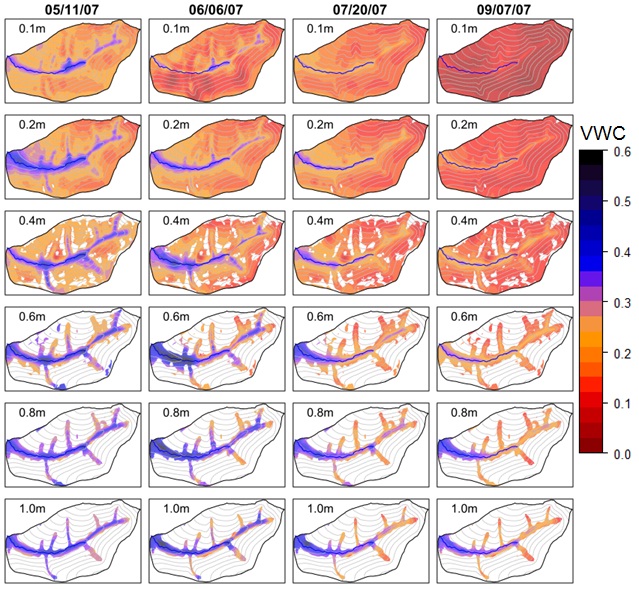Spatial and Temporal Variability in Soil moisture at the Catchment Scale
Soil moisture plays an important role in the non-linear response of streamflow to precipitation events. Better understanding of soil moisture temporal and
spatial variability will improve hydrologic models performance, help resource managers protect sensitive waterways and aid in the design of soil mositure
monitoring campaigns. Utilizing a long-term database of soil moisture measurements made at 100+ locations with the Shale Hills watershed, I investigated the physical factors
(topography, soil phyical properties, and hydrologic characteristics of the watershed) that controlled the spatial variability of soil mositure.
This project was completed while a MS student in the Crop and Soil Science Dept. at Penn State University, under the supervision of Dr. Henry Lin.
Publications and Presentations
1. Takagi, K., H. Lin, 2008. Influence of storm event characteristics on soil moisture at the Shale Hills catchment. First International Hydropedology
Conference. (Poster)
2. Takagi, K., H. Lin, 2009. Factors Controlling the Soil Moisture Spatial-Temporal Variability in the Shale Hills Watershed: A Hydropedologic
Perspective. 2009 ASA-CSSA-SSSA International Annual Meeting. (Poster)
3. Takagi, K., H.S. Lin. 2011. Temporal Dynamics of Soil Moisture
Spatial Variability in the Shale Hills Critical Zone Observatory. Vadose Zone J. 10:832842. doi:10.2136/vzj2010.0134.
4. Takagi, K., H.S. Lin. 2012. Changing controls of soil moisture
spatial organization in the Shale Hills Catchment. Geoderma 173174: 289-302. doi: 10.1016/j.geoderma.2011.11.003.
5. Zhao, Y., J. Tang, C. Graham, Q. Zhu, K. Takagi, H. Lin, 2012. Hydropedology in the Ridge and Valley: Soil Moisture Patterns and Preferential Flow
Dynamics in Two Contrasting Landscapes. In: Lin, H. (Ed.), Hydropedology: Synergistic Integration of Soil Science and Hydrology.
Academic Press, Elsevier B.V., pp. 381411.
